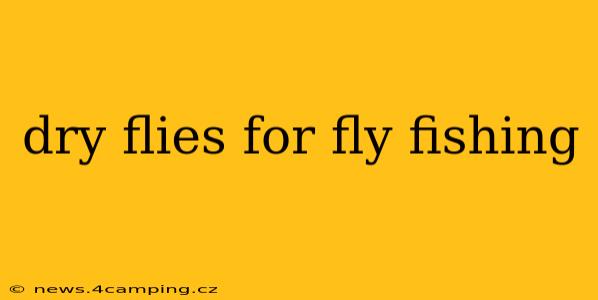Dry fly fishing, the art of presenting a fly that floats on the water's surface, is a rewarding and challenging aspect of the sport. It demands a keen eye for detail, precise casting technique, and a deep understanding of insect behavior. This guide delves into the world of dry flies, covering their types, materials, and effective techniques for successful fishing.
What are Dry Flies?
Dry flies are artificial flies designed to imitate terrestrial insects (like ants, grasshoppers, beetles) or aquatic insects (like mayflies, caddisflies, and stoneflies) that have emerged from the water and are resting or drifting on the surface. Their key characteristic is their buoyancy, allowing them to float high on the water's surface, mimicking the natural behavior of the insects they represent. This realistic presentation is crucial for enticing a trout or other fish to strike.
What are the Different Types of Dry Flies?
Dry flies come in a vast array of patterns, each designed to mimic a specific insect or to appeal to fish under varying conditions. Some common types include:
-
Mayfly imitations: These represent the various stages of a mayfly's life cycle, including duns (emerging adults), spinners (mated females laying eggs), and spent spinners (after egg-laying). These often feature delicate wings and fine hackles.
-
Caddisfly imitations: These flies mimic caddisflies, which often build cases from various materials. Patterns can range from simple to complex, featuring realistic body shapes and materials.
-
Ants and Beetles: Terrestrial insects like ants and beetles often fall onto the water's surface and provide an easy meal for trout. These dry flies are often characterized by their robust bodies and short, stubby wings.
-
Hoppers: Grasshoppers and other large terrestrial insects are also prime targets for trout. Hopper patterns typically have bulky bodies and long legs.
-
Stimulators: These are attractor patterns, not designed to precisely mimic a specific insect but rather to trigger a feeding response in fish with their movement and color.
What Materials are Used to Make Dry Flies?
The materials used in dry fly construction are carefully selected to ensure proper buoyancy and lifelike appearance:
-
Hook: The foundation of the fly, chosen based on size and strength.
-
Thread: Used to secure materials and create the body of the fly.
-
Body Materials: A wide range of materials can be used, including dubbing (a fuzzy fiber blend), fur, yarn, and even natural insect parts.
-
Wings: Materials like feathers (from various birds), elk hair, or synthetic substitutes create the fly's wings, contributing to its buoyancy and appearance.
-
Hackle: Feathers from a rooster's neck, used to create a lifelike appearance and add movement in the water.
What are Some Popular Dry Fly Patterns?
Several patterns consistently prove successful for anglers. Examples include the Adams, Royal Wulff, Elk Hair Caddis, Stimulator, and various ant and grasshopper patterns. The best pattern will depend on the specific location, time of year, and the insects present.
How do I Choose the Right Dry Fly?
Selecting the appropriate dry fly requires understanding the insects present on and near the water. Observe the water carefully, looking for insects on the surface film or emerging from the water. Match the fly's size, shape, and color to the natural insects as closely as possible. Consider the water conditions as well; a calm stream may require a smaller, more delicate fly, while a faster stream might call for a larger, more robust pattern.
What Makes a Dry Fly Float?
The ability of a dry fly to float is crucial for its effectiveness. This buoyancy is achieved through a combination of factors:
-
Materials: Floatable materials such as elk hair, deer hair, and certain synthetic fibers are used in the construction.
-
Construction: The fly's shape and weight distribution influence its floatability.
-
Floatant: A special floating solution (dry fly floatant) is applied to the fly's surface to enhance its buoyancy and repel water.
How to Keep a Dry Fly Afloat?
Maintaining the fly's float is essential. Regular application of floatant helps repel water and keep the fly riding high on the surface. Avoid repeatedly touching the fly with greasy fingers, as this can compromise its buoyancy.
Dry Fly Fishing Techniques
Successfully fishing dry flies requires a delicate touch and precise casting. Mending your line to keep the fly drifting naturally is vital. Pay close attention to the fish's behavior and adjust your presentation accordingly.
This guide offers a foundation for understanding dry flies. The art of fly fishing, particularly with dry flies, is a journey of constant learning and adaptation. Experimentation and observation are key to achieving success and enjoying the thrill of this challenging and rewarding fishing method.
